IFD OCO in Trading: What Does It Mean?
May 21, 2025
In the world of trading, advanced order types like IFD (If Done) and OCO (One Cancels the Other) offer more control and automation. When combined, IFD-OCO orders allow traders to plan entry and exit strategies in a single setup. This article explains what IFD-OCO means, how it works, and when to use it.
What Is IFD (If Done)?
IFD stands for “If Done.” This is a conditional order where the second order is only placed after the first one is successfully executed. It allows you to automate your trading strategy after entering a position.
For example, you can set a buy order at a certain price, and once it’s filled, a new sell or stop-loss order is automatically created.
Conditional order setup
Second order activates only if the first is completed
Used to automate trading workflows
Helps manage risk in advance
Ideal for disciplined entry planning
What Is OCO (One Cancels the Other)?
OCO stands for “One Cancels the Other.” It involves two orders: if one is executed, the other is automatically cancelled. This is often used to set a take-profit and stop-loss simultaneously.
OCO ensures that only one outcome can happen—either you exit with a profit, or you limit your loss.
Two linked orders
Execution of one cancels the other
Typically used for take-profit and stop-loss
Prevents conflicting trades
Helps manage exits efficiently
What Is IFD-OCO?
IFD-OCO is a combination of both order types. You first set a primary order (e.g., buy ETH at $1,800). Once this order is filled, two additional orders are triggered: a take-profit and a stop-loss. If either is filled, the other is cancelled.
This setup lets you automate the full trade lifecycle—from entry to exit—without needing to monitor the market continuously.
Entry order (IFD) triggers upon market condition
Two exit orders (OCO) are placed after entry
Automates both entry and exit
Suitable for volatile markets
Minimises emotional decision-making
When Should You Use IFD-OCO?
IFD-OCO is useful when you want a hands-off but structured approach to trading. It works best for traders who plan entries and exits in advance and want to manage risk with predefined conditions.
It is especially helpful in fast-moving or volatile markets.
When you want to automate entry and exit
To protect capital with stop-loss
To lock in profits with take-profit
If you can’t watch the market all day
When trading volatile assets like crypto
Conclusion
IFD-OCO is a powerful trading tool that helps automate your strategy and manage risks. By combining entry and conditional exit orders, it simplifies complex trading decisions and offers peace of mind—especially in volatile markets.
Now that you understand IFD-OCO, consider using it to build more disciplined and efficient trading strategies.
Start your safe cryptocurrency journey now
Fast and secure deposits and withdrawals, OSL safeguards every transaction !


